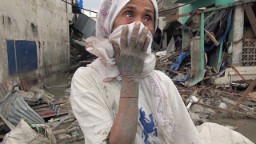Japan earthquakes: Dozens killed; 'race against the clock' to find survivors
Heavy rains were expected through Sunday after Japan's Kyushu region was struck by twin earthquakes, hampering the search for survivors and forcing nervous residents into crowded evacuation centers.
At least 32 people have died in the latest Kyushu earthquake, according to Kumamoto Prefecture's disaster management office. The magnitude-7.0 quake hit early Saturday.
Prime Minister Shinzo Abe described the search for survivors amid piles of rubble as a "race against the clock," noting that bad weather had conspired with the devastating quake, its aftershocks and the threat of landslides to make a dire situation worse.
In a Sunday morning press briefing, Abe said he received an offer of help from the U.S. military but it was not urgently needed yet. Japan has deployed 25,000 self-defense forces to the rescue effort, Suga said.
At least 23 people are buried inside buildings, Chief Cabinet Secretary Yoshihide Suga said.
"We're racing against the clock," Abe said. "(We) will provide more personnel if necessary."
Japan quakes by the numbers
Deaths linked to Thursday's quake: 9
Deaths linked to Saturday's: 32
Total deaths: 41
Total injured: 968
Evacuated: More than 91,700
Homes destroyed: 90
Homes damaged: 775
Timeline:
Thursday at 9:26 p.m.: 6.2-quake about 4.3 miles from the city of Ueki
Friday at 12:03 a.m.: 6.0-quake hits about 3.7 miles east of Uto.
Saturday at 1:25 a.m.: 7.0-quake hits about 0.6 miles from Kumamoto-shi.
Sources: Kumamoto Prefecture's disaster management office; USGS.
Residents were already on edge after a 6.2. quake rattled the area two days earlier, killing nine people. The combined death toll has reached 41. The two earthquakes left 968 people injured, according to the disaster management office.
"This is the worst thing that could happen to us," said Shigeru Morita, an official in the town of Mashiki, Kumamoto Prefecture.
The latest and most powerful earthquake struck near the city of Kumamoto, toppling buildings and bridges, shredding sections of landmarks into piles of debris, and sending frightened residents fleeing from their homes and into the night.
Thursday's earthquake hit near Ueki city, just 15 kilometers (9.3 miles) away.
"The first earthquake was very big," said Osamu Yoshizumi, the senior chief of international affairs in Kumamoto. "We thought it was the big one."
That initial earthquake was a "foreshock" to the latest one, according to USGS.
A bigger tremor would come overnight Friday.
"When the second earthquake came everything shook and I thought I might die," said Taiki Hishida, 38, who evacuated with his wife and two young children to a crowded shelter in Mashiki.
Samuel Borer, a U.S. citizen living in Kumamoto, said the latest quake struck at about 1:30 in the morning.
"It was just pitch black in the middle of the night and everything just started to go wild," he said.
Noel Vincent went through both earthquakes.
"This extremely intense shaking began," he told CNN International. "And whereas the first earthquake was more of an up-and-down type of shaking, this was a side-to-side shaking. I can't comment on what that is seismologically but I can tell you it was very intense and I feared for my life."
Television images and photos showed empty shelves at supermarkets and stores, leaving many evacuees to line up for food and water at shelters.
"There wasn't actually enough food for everyone, which was the only problem," said Borer, speaking at an elementary school being used as a shelter. "Most of the food went to the elderly and children first."
Kumamoto Prefecture continues to experience aftershocks, with about 165 so far.
"I feel every aftershock," said Yoshizumi, who was working from the city hall building in Kumamoto. "It's swaying here every hour."
CNN International's Matt Rivers, reporting from an evacuation shelter, said the aftershocks are creating great anxiety among rescuers and residents.
"You're seeing people assigned here from one of two sorts of tracks," he said. "On the one hand, people who had their homes destroyed so they have nowhere to go. (But) the reality is that most people inside this evacuation shelter here are afraid to go home. They're not sure that maybe there might be another aftershock."
The aftershocks also could hamper rescue efforts as emergency workers attempt to pull out people trapped in the rubble. TV Asahi showed crews crawling over a collapsed roof in an attempt to find an elderly couple. An 80-year-old man was rescued from the rubble, according to CNN affiliate TV Asahi.

Japan sees 3 major Earthquakes in only 24 hours
The tremors appear to have caused extensive damage, overturning cars, splitting roads and triggering a landslide as shown by TV Asahi footage. Television images showed flattened houses, shards of broken glass and debris piled onto the streets and people huddled outside. Nearly 92,000 people have evacuated, according to the prefecture's disaster management office.
News Courtesy: www.newagebd.net











